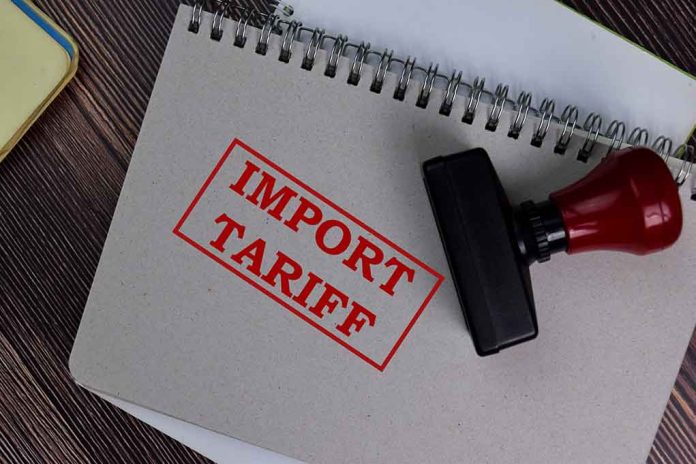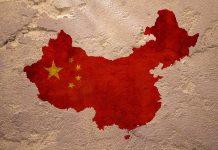
President Trump’s bold tariff move sparks fierce debate as Nucor Corp. CEO throws support behind ‘America First’ agenda.
Key Takeaways
- President Trump imposes 25% tariff on imports from Canada and Mexico, 10% on China, citing national security concerns.
- Nucor Corp., largest U.S. steel producer, endorses tariffs as crucial for strengthening American manufacturing.
- Tariffs aim to combat illegal immigration, drug trafficking, and unfair trade practices.
- Mixed market reactions: Steel stocks initially rally, but concerns over economic slowdown emerge.
- Uncertainty looms over tariff duration and potential retaliatory measures from affected countries.
Trump’s Tariff Strategy: Protecting National Interests
President Donald J. Trump has taken a decisive step in his “America First” trade policy by imposing significant tariffs on imports from Canada, Mexico, and China. The move, which imposes a 25% tariff on imports from Canada and Mexico and a 10% tariff on Chinese goods, is rooted in national security concerns, particularly illegal immigration and drug trafficking. This bold action has ignited a fierce debate among industry leaders, economists, and policymakers.
The White House justified these measures by citing the International Emergency Economic Powers Act (IEEPA), emphasizing the grave threat posed by illegal immigration and the influx of deadly drugs into the United States. President Trump’s stance is clear and uncompromising, as evidenced by his statement:
“sign all necessary documents to charge Mexico and Canada a 25% Tariff on ALL products coming into the United States, and its ridiculous Open Borders. This Tariff will remain in effect until such time as Drugs, in particular Fentanyl, and all Illegal Aliens stop this Invasion of our Country!” – President Trump – Source
Nucor Corp.’s Endorsement: A Boost for American Steel
In a significant development, Nucor Corp., the largest steel producer in the United States, has thrown its weight behind President Trump’s tariff strategy. The company’s CEO, Leon J. Topalian, voiced strong support for the “America First Trade Agenda,” viewing the tariffs as critical measures to bolster American manufacturing and ensure compliance with trade laws. This endorsement from a major industry player adds considerable heft to the administration’s policy stance.
Topalian’s support stems from the potential of these tariffs to address longstanding issues plaguing the U.S. steel industry, such as currency manipulation and subsidization of steel by foreign entities. These practices have long been viewed as detrimental to American manufacturers, threatening their competitiveness in both domestic and global markets. The CEO’s stance reflects a broader sentiment within the industry that stronger measures are necessary to level the playing field and protect American jobs.
🇺🇸Largest Steel Producer in US Announces Support of Trump Tariffs
“Nucor applauds the first steps taken by President Trump in his America First Trade Agenda. We look forward to working with @POTUS to enforce our trade laws & strengthen American manufacturing!” –Leon Topalian pic.twitter.com/CjszCkEWzD
— The White House (@WhiteHouse) February 3, 2025
Market Reactions and Economic Implications
The announcement of the tariffs initially sparked a rally in steel stocks, with investors anticipating increased profitability for domestic producers. However, this optimism was short-lived as concerns about potential economic slowdowns and retaliatory measures from affected countries began to surface. The tariffs are expected to raise steel prices in the U.S., benefiting domestic producers but potentially hurting industries that rely heavily on steel imports.
The automotive industry, a major consumer of steel, has shown particular vulnerability to these trade measures. General Motors, Ford, and Tesla all saw their stock prices decline in the wake of the tariff announcement, reflecting investor concerns about increased production costs and potential disruptions to supply chains. This reaction underscores the complex interplay between trade policy and various sectors of the economy, highlighting the challenges in balancing protectionist measures with overall economic growth.
The Road Ahead: Uncertainty and Potential Outcomes
As the dust settles on this major policy shift, uncertainty looms large over its long-term implications. The duration of these tariffs remains unclear, with their continuation potentially hinging on the development of border security agreements with Canada and Mexico. Moreover, the specter of retaliatory tariffs from affected countries adds another layer of complexity to an already intricate economic landscape.
President Trump’s unwavering commitment to his “America First” agenda is evident in his approach to leveraging economic measures for national security goals. His administration argues that the U.S., with trade being a smaller percentage of its GDP compared to Canada, Mexico, and China, is well-positioned to use its economic clout to secure its borders and combat drug trafficking.
As the situation continues to evolve, it’s clear that these tariffs represent more than just an economic policy – they are a bold statement of American priorities and a test of the nation’s resolve in the face of complex global challenges. The coming months will be crucial in determining whether this strategy achieves its intended goals or leads to unforeseen consequences in the intricate web of international trade and diplomacy.






















